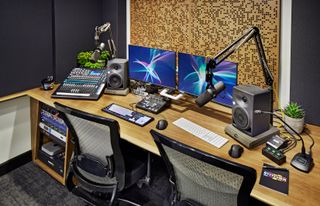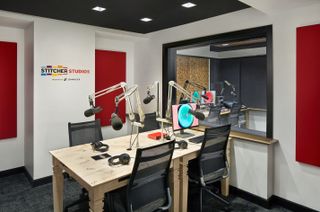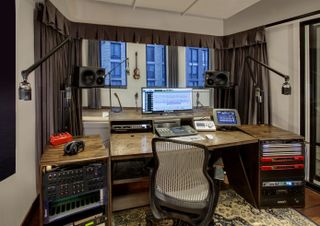When modern mass media was still young, a 1938 radio adaptation of The War of the Worlds by Orson Welles famously sent listeners into a panic as realistic “reports” of an alien invasion were broadcast over the airwaves. There was no reason for alarm, of course. Aliens weren’t really invading New York City. But over the course of that program, Welles proved the power of realism in communications.
Production values have improved light years since then, and listeners’ ears have adapted to the enhancements afforded by ever-more-sophisticated audio technologies. As podcasts—the modern-day equivalent of those early talk-format broadcasts—have increased in popularity, so has the need for professional standards.
Today, the market reach for podcasts distributed over the internet and through app platforms like Spotify dwarf the market share of traditional broadcast media such as terrestrial and satellite radio, with more than 700,000 active podcasts containing a catalog of more than 29 million episodes.
This explosion in podcasting has leveled the playing field for content creators and is offering new opportunities for studio designers.
“You don’t need $1 million worth of equipment to start,” said John Storyk, director of design and founding partner at Walters-Storyk Design Group. “You just need 45 minutes of a subject and some listeners. And if your subject’s good, your listeners get bigger.”
Soren Pedersen, senior product specialist at Shure, agrees. “It is a really basic formula—simple room absorption and a dynamic mic. The startup cost for a simple interface and a couple dynamic mics with stands and cables is minimal. In general, there are just fewer pieces of equipment you need to work with.”
While the entry threshold to podcasting is low, the grade is steep to getting ranked at the top of the charts. Podcasts that begin in a bedroom or minimalist studio with an audio interface and a microphone like Shure’s SM7B, which has been used on programs like Serial, can quickly exceed their own production capabilities. That’s where professional podcast studios enter the picture.

Walters-Storyk Design Group has worked with major podcasting production houses like Gimlet Media and Stitcher, among a dozen others, to build studios with facilities large enough to accommodate multiple interviewers or group recording, as in the days of radio theater, as well as the technology for complex editing and the recording of sound beds and original scores.
Gimlet Media, which was purchased by Spotify earlier this year for more than $200 million, invested a great deal of time and money into creating spaces where content producers can engineer their own podcasts. Custom tablet-style touchpanels allow producers to easily control the room.
“Gimlet has done a lot of work to streamline the engineering process so somebody could come in and within five or 10 minutes learn the system, learn how to arm mics, learn how to bring in a phone call, mute a mic, or bring in somebody’s laptop and run a session,” said Storyk.
All of that convenience requires a heavy lift on the front end to create the stable, consistent environment needed for professional recording. That process can involve reinforcing walls for soundproofing and re-engineering spaces that were intended to be offices, not recording studios. Low ceilings and densely clustered rooms are a key challenge.
“Although Gimlet is in Brooklyn in a loft-like space, Stitcher is in a Manhattan office building, but the ceilings aren’t tall,” Storyk explained. “And all these rooms have to be next to each other, but they all have to be quiet. Technically speaking, they all need to be in the NC [noise criteria] 15 category, which is quite low.”
Building walls 12 inches thick can get the noise rating to NC-15 levels, the standard for all types of recording studios, but making the rooms sound identical to each other is another story. It’s also an important one, considering how many podcasts are recorded. The creation of a single episode may require multiple recording sessions, sometimes in different rooms, depending on the facility schedule, with multiple voices that have different timbres.

“We’ve done vocal booths and iso booths for 50 years, but all these [podcast recording] rooms have to sound virtually identical, both in a system sense and an acoustic sense,” Storyk said. “The podcasts these companies make—and that future-forward companies will be making—are much more sophisticated, and they’re not all made at the same time. They may have three or four interview sessions” for a single episode.
During the room-testing phase of construction at Gimlet, their engineers recorded in each of the studio’s 11 rooms to observe any anomalies. After they discovered subtle inconsistencies with reflection and decay rate, the WSDG team was able to make adjustments so the rooms’ audio characteristics would be consistent.

Established companies like Gimlet and Stitcher know what to expect during a buildout, but clients new to studio recording likely aren’t familiar with the process. There is a degree of expectation management that audio designers must prepare for, which can include everything from timelines to budgets.
“You have to manage expectations on the build part,” Storyk said. “Both of these projects [Gimlet and Stitcher] had very, very talented chief engineers. Those are the people who sort of became the project managers. Basically, the head IT guys are the closest ones to keeping track of this.”
Storyk recommends audio design companies get involved in podcasting buildouts before designs are finalized. At a recent conference, representatives from both companies expressed how they wished they had more time in the design and planning stages, and a better understanding of what the process would look like. “Got to get the design teeth in there early. It’d save you a lot of money, a lot of aggravation,” Storyk noted.
As podcasts continue to grow in popularity, manufacturers, audio system designers and installers are bullish on the possibilities. As in the days of Welles’ The War of the Worlds broadcast, creative productions have an advantage over less professional podcasts.
“There is a huge market for podcast production services like recording and editing,” said Pedersen. “It’s big enough to support full-time freelance producers and editors. Many people, organizations, and businesses have a need for a podcast but don’t have the background on where to start. It is a great opportunity for AV professionals to get involved and help.”
Providing leadership and expertise in emerging markets is important to the continued evolution of the AV industry, especially when the parameters and expectations are still wide open.
“We’re in the Wild West on all of this stuff,” concluded Storyk. “There’s no fixed way to do it. But you can see there’s this giant boulder—it’s rolling downhill [and] pushing each of these podcasting content companies to make better podcasts.”












